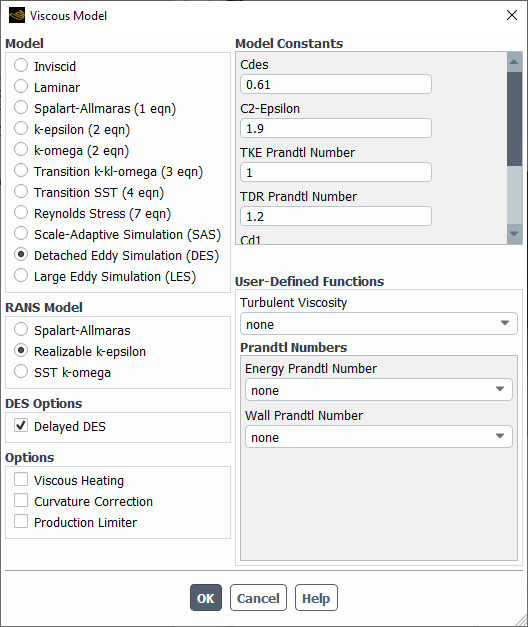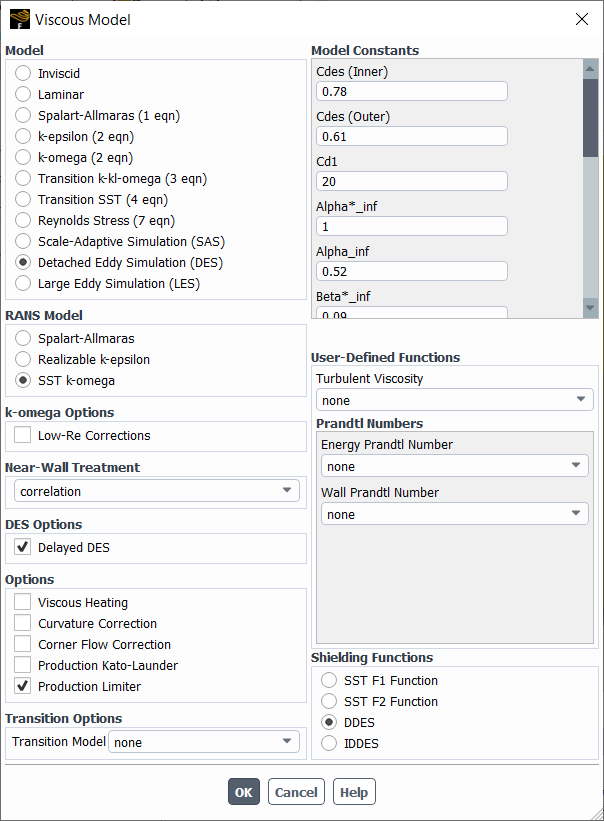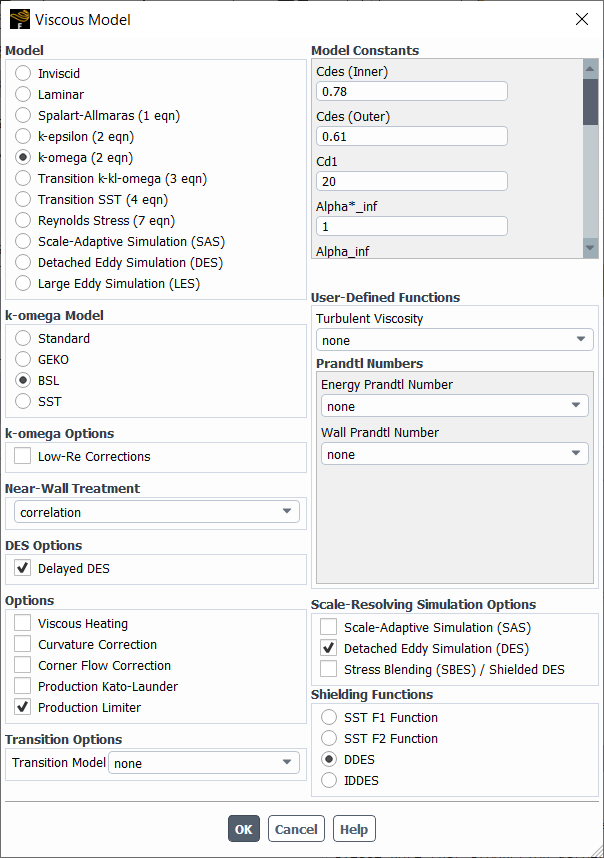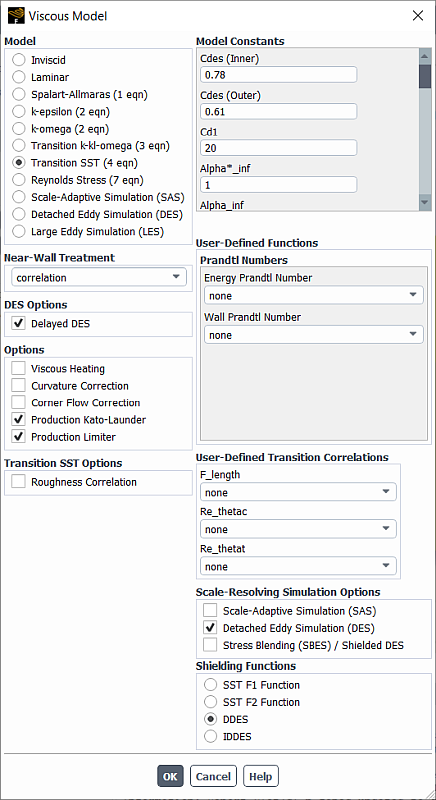When using the Detached Eddy Simulation (DES) model, the following underlying RANS turbulence models can be used:
Spalart-Allmaras
Realizable
-
SST
-
BSL
-
Transition SST
Note that for the DES model, the Bounded Central Differencing scheme (available in the Solution Methods task page) is recommended for momentum discretization, and is the default setting.
For additional information, see the following sections:
To set up a Detached Eddy Simulation with the Spalart-Allmaras model, select Detached Eddy Simulation (DES) from the Model list in the Viscous Model dialog box and then select Spalart-Allmaras from the RANS Model list.
Ansys Fluent uses Equation 4–271 (in the
Theory Guide) to compute
the value of the length scale for the Spalart-Allmaras model. By default, the empirical constant
is set to 0.65. You can change its value in the
Cdes field under Model Constants. The
following options are available for this model:
vorticity-based production (Vorticity- and Strain/Vorticity-Based Production)
strain/vorticity-based production (Vorticity- and Strain/Vorticity-Based Production)
delayed DES (Delayed Detached Eddy Simulation (DDES))
viscous heating (always enabled for the density-based solvers) (Including the Viscous Heating Effects)
inclusion of curvature correction (Including the Curvature Correction for the Spalart-Allmaras and Two-Equation Turbulence Models)
Figure 15.22: The Viscous Model Dialog Box Displaying Options for DES with the Spalart-Allmaras Model

Additionally, you can perform the following DES-specific function by using the
/define/models/viscous/detached-eddy-simulation? text
command:
Modify only the length scales that appear in the destruction term in
equation (the default is to modify all length scales within the
equation)
To set up a Detached Eddy Simulation with the Realizable -
model, select Detached Eddy Simulation (DES)
from the Model list in the Viscous Model
dialog box and then select Realizable k-epsilon from the
RANS Model list.
The model-specific options for DES with the Realizable -
model are the following:
delayed DES (Delayed Detached Eddy Simulation (DDES))
viscous heating (always enabled for the density-based solvers) (Including the Viscous Heating Effects)
inclusion of compressibility effects (Including the Compressibility Effects Option)
The model constant is set to 0.61 for the Realizable
-
model (see DES with the Realizable k-ε Model in the Theory Guide). The enhanced wall treatment
(EWT-
) is always enabled for DES with the Realizable
-
model (see Enhanced Wall Treatment ε-Equation (EWT-ε) in the Theory Guide).
To set up a Detached Eddy Simulation with the SST -
model, select Detached Eddy Simulation (DES)
from the Model list in the Viscous Model
dialog box and then select SST k-omega from the RANS
Model list.
The model-specific options that you can select for DES with the SST
-
model are the following:
low-Re corrections
-
option (Low-Re Corrections)
near wall treatment (y+-Insensitive Near-Wall Treatment for ω-based Turbulence Models in the Fluent Theory Guide)
delayed DES (Delayed Detached Eddy Simulation (DDES))
viscous heating (always enabled for the density-based solvers) (Including the Viscous Heating Effects)
inclusion of curvature correction (Including the Curvature Correction for the Spalart-Allmaras and Two-Equation Turbulence Models)
inclusion of production limiters (Including Production Limiters for Two-Equation Models)
inclusion of the Intermittency Transition Model
Shielding functions—F1, F2, DDES (Delayed DES) and IDDES (Improved Delayed DES)—are available when the delayed DES option is enabled (Shielding Functions for the BSL / SST / Transition SST Detached Eddy Simulation Model)
The model constant is set to 0.61 for the SST
-
RANS model (see DES with the BSL or SST k-ω Model in the Theory Guide).
To set up a Detached Eddy Simulation with the BSL -
model for a transient case, select k-omega
from the Model list in the Viscous Model
dialog box, select BSL from the k-omega
Model list, and enable the Detached Eddy Simulation
(DES) option in the Scale-Resolving Simulation
Options group box.
The model-specific options that you can select for DES with the BSL
-
model are the following:
low-Re corrections
-
option (Low-Re Corrections)
near wall treatment (y+-Insensitive Near-Wall Treatment for ω-based Turbulence Models in the Fluent Theory Guide)
delayed DES (Delayed Detached Eddy Simulation (DDES))
viscous heating (always enabled for the density-based solvers) (Including the Viscous Heating Effects)
inclusion of curvature correction (Including the Curvature Correction for the Spalart-Allmaras and Two-Equation Turbulence Models)
inclusion of compressibility effects (Including the Compressibility Effects Option)
inclusion of production limiters (Including Production Limiters for Two-Equation Models)
inclusion of the Intermittency Transition Model
Shielding functions—F1, F2, DDES (Delayed DES) and IDDES (Improved Delayed DES)—are available when the delayed DES option is enabled (Shielding Functions for the BSL / SST / Transition SST Detached Eddy Simulation Model)
The model constant is set to 0.61 for the BSL
-
RANS model (see DES with the BSL or SST k-ω Model in the Theory Guide).
To set up a Detached Eddy Simulation with the Transition SST model for a transient case, select Transition SST from the Model list in the Viscous Model dialog box and then enable the Detached Eddy Simulation (DES) option in the Scale-Resolving Simulation Options group box.
For DES with the Transition SST model, you can choose to enable the Delayed DES option in the DES Options group box (see Delayed Detached Eddy Simulation (DDES) for details). When this option is enabled you can make a selection from the Shielding Functions list, as described in Shielding Functions for the BSL / SST / Transition SST Detached Eddy Simulation Model.
Note that the y+-insensitive wall treatment of the underlying turbulence model is used. For details on the available options, see y+-Insensitive Near-Wall Treatment for ω-based Turbulence Models in the Fluent Theory Guide.






